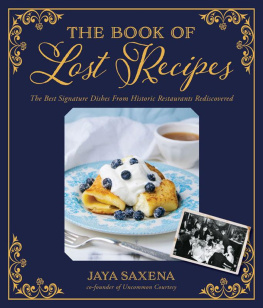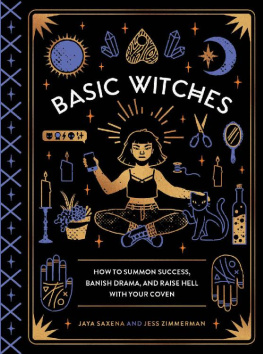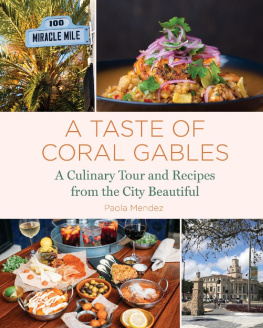THE BOOK OF
Lost Recipes
The Best Signature Dishes
From Historic Restaurants Rediscovered
JAYA SAXENA
co-founder of Uncommon Courtesy

Thank you for buying this
Page Street Publishing Co. ebook.
To receive special offers, bonus content,
and info on new releases and other great reads,
sign up for our newsletters.

Or visit us online at
us.macmillan.com/newslettersignup
The author and publisher have provided this e-book to you for your personal use only. You may not make this e-book publicly available in any way. Copyright infringement is against the law. If you believe the copy of this e-book you are reading infringes on the authors copyright, please notify the publisher at: http://us.macmillanusa.com/piracy.
To my parents, for all of your support, and to Matt, for your enduring love and willingness to eat a bunch of weird, historic dishes
Think of the restaurant that changed your life. Is that too dramatic? Maybe its the diner you went to every night in high school, or the place you saved up every penny to eat at, or just the place you always return to when its been too long. It may have been famous, historic or new, or it may just have been there, but whatever it was, it was yours. Mine is an old Italian place in New Yorks East Village, Lanzas. Its where there are trompe loeil paintings of Mt. Vesuvius on the walls and its not uncommon to hear the Godfather theme playing softly in the backyard. I order a carafe of house wine and the special spaghetti with tomatoes and thick chunks of mozzarella, or the mozzarella in carrozza with what I maintain is the best marinara sauce in the city. Many places probably make all these things just as well, but that will never matter to me.
Restaurants are inherently special. The experience of dining out is still a relatively new one, and even in instances where its a necessity (for quick lunches during work, for any food at all if ones apartment lacks a kitchen), it still feels like a treat. Its about the food, but its about more than thatatmosphere, community, class. Thus, what we seek in a restaurant, our restaurants, is somewhat aspirational, and when they succeed its because theyve tapped into the needs and desires of a place and time. The Book of Lost Recipes is about places that did just that.
When researching the restaurants in this book, I was driven by the question What made this place this place? What made it famous, or beloved, or kept it in the hearts and minds of its community long after the doors shut? The goal here is to provide a glimpse into the differences, and similarities, of dining culture around America in the 20th century, because dining culture is unique from food culture as a whole. What people make in the home is not what they crave in a restaurant.
Exactly what we are looking for and respond to in a restaurant changes by region, year, economy and a number of other factors, but there is one thing that they all seem to have in common: comfort. Comfort comes in many forms. In some places, its a restaurant opened by immigrants, serving the food of a home country to people who couldnt find it elsewhere. In others, its fine-dining establishments that know how to gently introduce new flavors to a posh audience. Sometimes its a charming owner or a trusted family who become pillars of their communities. Sometimes its about providing for the ignored or oppressed. And sometimes its just about being reliable, being good and being there. In all cases, these restaurants reflect our populations, our economy, our views on race and class, and our aspirations. These swirl together and, for moments sometimes too brief, make these places something more.
Lanzas also happens to be one of the last relics of a dying population. The East Village has changed in the hundred-plus years since Lanzas opened. The Italians largely moved out, and new people moved in, bringing with them the types of businesses they want to frequent, whether you call that gentrification or the hand of the free market. Lanzas stands with a few other institutions, the sole survivors of a slew of others that looked just like them. It represents a success, for now, in a familiar story of failure. Or really, a story of preservation in a familiar story of change.
Things, indeed, have changed. A common refrain I heard in my research is that we have lost dining out as an experience. I dont think thats the case. We have made tremendous gains in this pocket of society, whether its the growing respect for diverse cultures and cuisines, an increasingly adventurous national palate, or just the fact that our restaurants are no longer segregated. Many things have changed for the better. But certainly there are things we have lost. There are places here that could not be built today. Populations move and change, economies rise and fall, and the conditions that spelled success for a restaurant can just as quickly spell its demise. The Book of Lost Recipes is about the places now remembered as special. Sometimes they were famous, sometimes they werent, and in some cases, they were strange vestiges of times wed rather forget.
The Book of Lost Recipes is about this change, but its also aboutwhat elsethe food. Whatever other factors came into play, the fact is none of these places would have been as beloved if what they were serving wasnt good. And as much as the book is a glimpse into dining culture, its also a glimpse into Americas changing dining preferences. We see the days when an elaborate Baked Lobster Savannah was the peak of elegance, rather than anything described as molecular gastronomy. When chili was the hot new food sweeping Oregon. When the people of Detroit would spend their hot summer Sundays boating across the river for fresh frog legs.
We may have lost the restaurants, but luckily, in some cases, the food can be resurrected. With a bite of chopped liver we can picture the Romanian Steakhouse on Manhattans Lower East Side where Jewish vaudeville stars danced to klezmer. With a sip of punch we can imagine the Tiki behemoth towering over Columbus, Ohio. With a curried meatball we can see the leaps and bounds Indian cuisine has made in fifty years. By cooking and tasting what we ate, we can start to answer the questions of why we ate it, and sometimes ask ourselves why we stopped in the first place.
The recipes in this book are representative of their own places and times, enhanced by the context of their histories. They are also good recipes. Some may be familiar and others may be complete throwbacks, or may even feel entirely new, but they are the things memories are made of. Think back to your restaurant, the dish that captured your attention, the one that you go back to whenever you need it, or wish you could go back to. These dishes were those things for someone of a different time, and making them connects us to the lives and past of a place we would have never otherwise experienced. It is quite possibly the best way to time travel.

Scenery Hill, PA
Opened 1788
Originally, towns along Braddock Road were twelve miles (19 km) apart. Thats because twelve miles was as long as your average oxen could travel in a day. Braddock Road bled into the National Road, and was used as a stagecoach line, the only road funneling anyone from east to west in the area. Stephen and Thomas Hill, the owners of the stagecoach company, knew this gave them a captive audience and in 1788 began building Hills Tavern.










